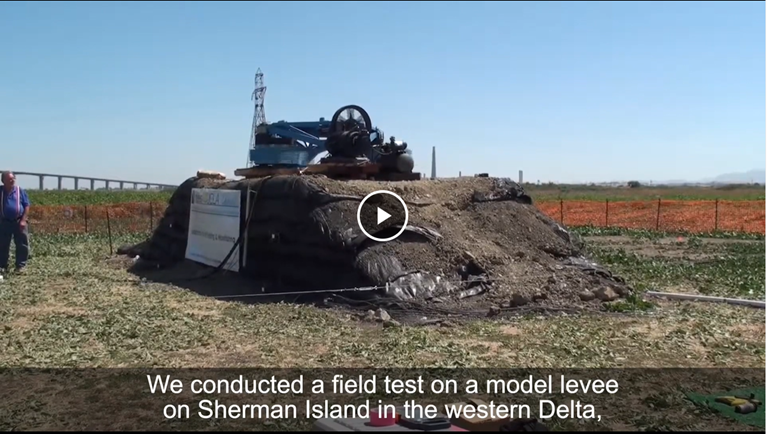Q/A: What are the risks of a major earthquake in the Sacramento-San Joaquin Delta? (Part 2)
A model levee on Sherman Island being tested with an MK-15 eccentric mass shaker as part of a 2019 UCLA study into seismic risk in the Sacramento-San Joaquin Delta.
In the second of two Delta Conveyance Deep Dive episodes on seismic risks in the Sacramento-San Joaquin Delta, we hear from two of California's leading seismology experts about the vulnerability of the Delta to a major seismic event. Scott Brandenberg, professor of civil and environmental engineering at the University of California, Los Angeles, and Dr. Norm Abrahamson, adjunct professor in civil and environmental engineering at the University of California, Berkeley and University of California, Davis, are consultants to the Delta Conveyance Design and Construction Authority.
The conversation was moderated by Patricia Clark, associate governmental program analyst in the Delta Conveyance Office. Watch the full interview.
Q. Scott, shortly after the 2014 Napa quake, you wrote in the L.A. Times that we had dodged a bullet and that the catastrophic scenario of years of salty water in the Delta might have occurred had the earthquake struck near or beneath the Delta. Why do you think we didn't see levee failure from that 2014 Napa earthquake?
A. Scott Brandenberg: Yes, thanks Pat. I said that we dodged a bullet because that magnitude-6 event that happened in Napa could happen in the Delta, or a bigger magnitude earthquake could happen that could shake the levees more strongly.
Norm Abrahamson: We have to keep in mind that all earthquakes are not the same. There's tremendous variability in how strong the shaking is from one earthquake to the next. That's why we model all these things because we can't tell you exactly what's going to happen. But that shaking [from the 2014 Napa earthquake] in the Delta was not at all representative of what we'd see from a local magnitude 6 on any of the nearby faults. We would expect much stronger shaking to occur.
Q. Scott, back to you. It's often suggested that rather than spending a lot of money on building the Delta Conveyance tunnel, we just should reinforce all the vulnerable levees. Is this a realistic proposition? Is it possible to design levees to withstand strong earthquakes?
A. Scott Brandenberg: That's a great question, Pat. It's possible to design them. It would maybe cost a lot of money because a levee system is a series system. So if we think about an island that's protected by the levees that go around the perimeter of the island, if any part of the levee settles too much and gets overtopped, it will erode away and fail. So, an island that has, say, 20 kilometers of levee around it, the question is, how do we design these levees so that no spot around this entire length of levee fails, and that's a real challenge. I always use the weakest link in the chain analogy. If you pull on a chain, the weakest link is the one that will control the whole capacity of the chain; and. levee systems are like that. So, it's really difficult for us to know for sure that no bad spot is going to exist on all of these long levee systems that protect the islands in the Delta.
Q. As we heard in part 1 of this seismic risk discussion, the proposed Delta Conveyance Project would help to guarantee the State's water supply in the event of an influx of saltwater into the Delta, near the existing water pumps, by providing conveyance intakes in the North Delta. But what about the safety of a tunnel in an earthquake? What is it about a tunnel that makes it better able to withstand an earthquake rather than a canal or pipes on the surface?
A. Scott Brandenberg: There are two aspects. I think Norm maybe can talk about the distribution of ground motion with depth, but I'll talk about the surficial soils. We have this peat soil up near the surface. There are liquefiable materials within the levee itself and right beneath the levee in some cases. And all of those problematic soils are really the driver of levee risk. So, by putting the tunnel beneath all of those soft sediments, we take away that part, that geotechnical hazard that is related to the potential for failure of these shallow sediments. Norm, do you want to talk about the ground shaking?
Norm Abrahamson: Yes, Scott. The advantage of a tunnel is that you're at depth, and the ground motion at depth is much less than the ground motion at the surface. The other key factor is that tunnels for seismic design are mainly sensitive to something called the peak velocity. They are much less sensitive to the duration of shaking. So that makes it less impacted by these long duration, big earthquakes in the Bay Area that are more likely. And I think fundamentally you can just design a tunnel with much more confidence that it will perform as planned. As Scott mentioned, working at the surface, the uncertainties are just so large that we can't be confident that any design that we have come up with on the surface will actually give us the good performance that we're after. But working down at depth in the tunnels, we can. We have much less uncertainty and we'll be much more confident that we've got a design that will last for a long time.
